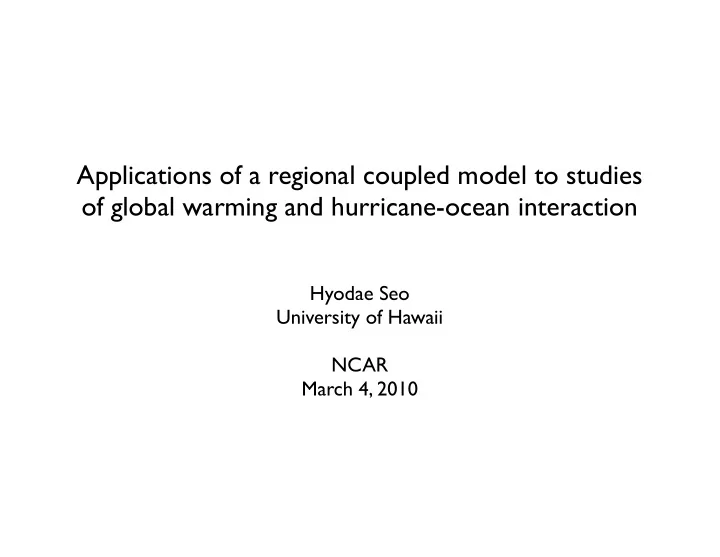

Applications of a regional coupled model to studies of global warming and hurricane-ocean interaction Hyodae Seo University of Hawaii NCAR March 4, 2010
Outline 1. Climate simulation : downscaling projection of global warming scenario ➔ Role of oceanic eddies and currents in Atlantic. 2. Weather simulation : Impact of ocean state (SST, D26, UOHC) on TC intensity ➔ Case study of Hurricane Katrina
1. Equatorial Atlantic Ocean’s response to global warming forcing
• CGCMs for projections of climate change need to resolve all the relevant feedback processes. • Example: Tropical instability waves (TIWs) • Not well-resolved in IPCC-AR4 models and their impact is unexplored. • So we need to resolve them by downscaling. SST snapshots from NOAA OI SST (25 km) on July 27, 2007
Model and experiments Scripps Coupled Ocean-Atmosphere Regional Model (Seo et al. 2007, J. Climate ) Atmosphere: Regional Spectral Model (Scripps RSM) Ocean: Regional Ocean Modeling System (ROMS) CTL • CTL : RSM (NCEP2 6hrly) + ROMS (SODA monthly) ➜ ➜ ATM • 25 km ROMS + 50 km RSM ROMS RSM ➜ ➜ SST • Daily coupling based on Fairall et al. (1994) ➜ ➜ • 28-yr. integration: 1980-2007 NCEP2 SODA • Atmospheric spectral nudging > 1000 km GW • δ =GFDL CM2.1 monthly difference: (2045-2050: A1B)- ➜ ➜ Flux ROMS (1996-2000: 20C); 10-member ensemble mean RSM ➜ ➜ SST • GW : RSM (NCEP2 6-hrly + δ ) + ROMS (SODA monthly + δ ) ➜ ➜ Quasi-steady state NCEP2+ δ SODA+ δ GW-CTL pseudo global warming experiment
Simulation of present-day climate GW response (GW-CTL) • Reduced warming in the equator • Intensified cross-equatorial meridional winds and surface divergence • Zonal SST gradient and equatorial cold tongue in SCOAR
Why reduced waring in cold tongue? ➔ Eg., Change in vertical temperature advection within cold tongue ✔ ➋ ➌ ➍ ➊ <>: climatological mean (CTL) *: Perturbation from global warming ! (GW-CTL) ➊ ➋ ocean dynamical thermostat (Clement et al. 1996) ➊ : climatological equatorial upwelling ➋ : Weak warming (cooling) in the west (east) due to thermal stratification ✔ ➋ + ➌ ➌ ➌ : Stronger cooling by increased vertical velocities cf., an ocean dynamical thermostat in the Pacific and the Atlantic. ➌
Change in equatorial zonal currents and equatorial instability SEC • 30 ° W-10 ° W • EUC/SEC/NECC/TJ EUC are more realistic (stronger) in SCOAR. • Stronger northward cross-equatorial wind ➔ Stronger EUC ( Philander and Delecluse, 1983 )
Change in atmospheric circulation ➜ changes in ocean circulation ➜ equatorial dynamic instability Barotropic convergence rate (a) Barotropic conversion rate 70 CTL 60 GW [10 -6 kgm -1 s -3 ] 50 • Barotropic and 40 30 baroclinic convergence 20 are dominant energy 10 sources for the TIWs. 0 3S 2S 1S EQ 1N 2N 3N 4N 5N • Both BT and BC are Baroclinic convergence rate (b) Baroclinic conversion rate 70 strengthened under the CTL 60 GW environmental changes [10 -6 kgm -1 s -3 ] 50 associated with global 40 warming 30 20 10 0 3S 2S 1S EQ 1N 2N 3N 4N 5N
Strengthening of TIWs ( 20-40 day band-pass filtered EKE and SST variance) CTL EKE GW EKE (b) GW EKE (a) CTL EKE 120 5N 5N 100 80 2.5N 2.5N 60 40 EQ EQ 20 2.5S 2.5S 0 40W 20W 0E 40W 20W 0E • EKE and TIW-SST GW SST Variance CTL SST Variance (c) CTL SST VAR (d) GW SST VAR variance all become 5N 5N stronger during the 0.1 0.08 cold season (~30%). 2.5N 2.5N 0.06 0.04 EQ EQ 0.02 2.5S 2.5S 40W 20W 0E 40W 20W 0E Seasonal cycle of SST Variance Seasonal cycle of EKE 0.1 (f) Climatology of SST VAR 150 (e) Climatology of EKE CTL CTL GW GW 100 0.05 50 0 0 1 3 5 7 9 11 1 3 5 7 9 11 month month
Annual mean mixed layer ocean heat budget (30 ° W-10 ° W) δ Eddy-NET δ Upwelling • Equatorial upwelling (cooling) increases due to the increased vertical velocities associated with the surface divergence. cf. the tropical Pacific. • Net eddy heat flux by TIWs is warming in CTL and increases under global warming forcing, damping the effect of increased upwelling.
Summary of Part I • Exploratory research : The first coupled downscaling of climate change scenarios • Downscaling captures equatorial currents and mesoscale variabilities • Upwelling increases. Currents intensify. TIWs strengthen. Impact spatial pattern of mean state warming. • Need to resolve high-freq. processes in the model for global warming research. • Challenge: Drift in mean state in a long-term integration. • Need a consistent nudging technique for large-scale circulations both of the ocean and atmosphere.
2. Impact of ocean state on TC intensity ➔ Hurricane Katrina
Recommend
More recommend